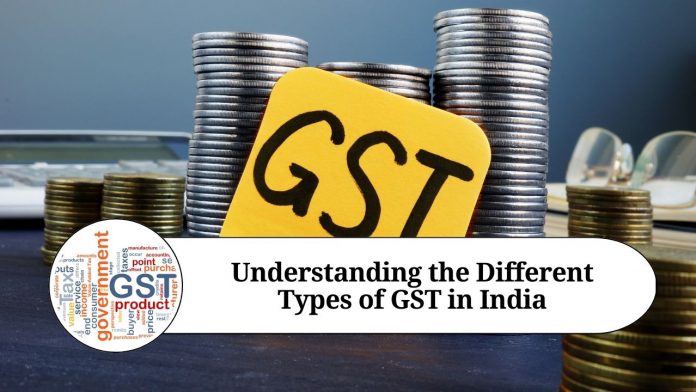Introduction
Goods and Services Tax (GST) is a comprehensive indirect tax system that has been implemented in India to replace multiple indirect taxes levied by the central and state governments. GST is a consumption-based tax that is levied at every stage of the supply chain, right from the manufacturer to the end consumer.
There are several types of GST that are applicable in India. Let’s take a look at them in detail.
- Central GST (CGST): CGST is the tax levied by the central government on intra-state supplies of goods and services. It is levied at the point of sale and collected by the central government.
- State GST (SGST): SGST is the tax levied by the state government on intra-state supplies of goods and services. It is also levied at the point of sale and collected by the state government.
- Integrated GST (IGST): IGST is the tax levied by the central government on inter-state supplies of goods and services. It is collected by the central government and then distributed among the states where the goods and services are consumed.
- Union Territory GST (UTGST): UTGST is the tax levied by the central government on supplies of goods and services in the Union Territories. It is similar to SGST and is collected by the central government.
- Compensation Cess: Compensation Cess is a tax that is levied on certain goods and services that are considered luxury or sin goods, such as cigarettes, aerated drinks, and cars. The revenue collected through this tax is used to compensate the states for any revenue losses incurred due to the implementation of the GST.
- Other Taxes: Apart from the above-mentioned types of GST, there are also some other taxes that are levied in special cases. For example, the GST on the import of goods is known as Import GST, and the tax on exports is known as Export GST.
Central GST (CGST): CGST is a tax levied by the central government on the supply of goods and services within a state. It is charged on the value of the transaction and is collected by the central government. The revenue collected through CGST is then divided between the central and state governments, with the central government retaining half of the revenue and the other half being distributed to the state government.
- State GST (SGST): SGST is a tax levied by the state government on the supply of goods and services within a state. It is charged on the same value as CGST, and the revenue collected is entirely retained by the state government. SGST is applied on top of CGST, which means that the total tax levied on a transaction within a state is the sum of CGST and SGST.
- Integrated GST (IGST): IGST is a tax levied by the central government on the supply of goods and services between states. It is charged on the value of the transaction and is collected by the central government. Unlike CGST and SGST, IGST is a single tax that replaces both central and state taxes. The revenue collected through IGST is then distributed among the states where the goods and services are consumed.
- Union Territory GST (UTGST): UTGST is a tax levied by the central government on the supply of goods and services within Union Territories. It is charged on the value of the transaction and is collected by the central government. The revenue collected through UTGST is entirely retained by the Union Territory where the transaction takes place.
- Compensation Cess: Compensation Cess is a tax levied on certain goods and services that are considered luxury or sin goods. The revenue collected through this tax is used to compensate the states for any revenue losses incurred due to the implementation of the GST. Compensation Cess is levied on top of CGST, SGST, and IGST and is applicable to goods such as cigarettes, aerated drinks, and cars.
- Other Taxes: Apart from the above-mentioned types of GST, there are also some other taxes that are levied in special cases. For example, the GST on the import of goods is known as Import GST, and the tax on exports is known as Export GST.
In conclusion
GST has simplified the taxation system in India by replacing multiple indirect taxes with a single tax. The different types of GST are designed to ensure that tax is levied appropriately and that revenue is distributed among the central and state governments. Understanding the types of GST is essential for businesses and individuals to comply with the taxation system and avoid any penalties or fines.
Read more useful content:
- section 234e of income tax act
- section 286 of income tax act
- section 90a of income tax act
- section 40a(7) of income tax act
- section 226(3) of income tax act
- section 24 of income tax act
Frequently Asked Questions (FAQs)
Q:1 What is GST?
A: GST (Goods and Services Tax) is an indirect tax that is levied on the supply of goods and services in India. It is a comprehensive, multi-stage, destination-based tax that is levied on every value addition.
Q:2 What are the different types of GST?
A: There are three types of GST in India: CGST, SGST, and IGST.
Q:3 What is CGST?
A: CGST (Central Goods and Services Tax) is a tax levied by the Central Government on intra-state supplies of goods and services. It is collected by the Central Government.
Q:4 What is SGST?
A: SGST (State Goods and Services Tax) is a tax levied by the State Government on intra-state supplies of goods and services. It is collected by the State Government.
Q:5 What is IGST?
A: IGST (Integrated Goods and Services Tax) is a tax levied by the Central Government on inter-state supplies of goods and services. It is collected by the Central Government but later distributed to the respective States.
Q:6 How are CGST, SGST, and IGST different from each other?
A: CGST is levied by the Central Government on intra-state supplies, while SGST is levied by the State Government on intra-state supplies. IGST, on the other hand, is levied by the Central Government on inter-state supplies. The revenue collected from CGST and SGST stays within the state, while the revenue collected from IGST is distributed between the Centre and the State.
Q:7 What is the rate of GST in India?
A: The rate of GST in India varies depending on the type of goods and services. There are four slabs: 5%, 12%, 18%, and 28%. There is also a zero rate for certain items, while some goods and services are exempt from GST.
Q:8 How is GST calculated?
A: GST is calculated on the value of the goods or services, inclusive of all taxes, duties, and charges. The GST amount is calculated by multiplying the value of goods or services by the applicable GST rate.
Q:9 Who is liable to pay GST?
A: Any business or individual that supplies goods and services is liable to pay GST if their annual turnover exceeds the prescribed threshold limit. Small businesses with a turnover below the threshold limit are exempt from GST registration.




















